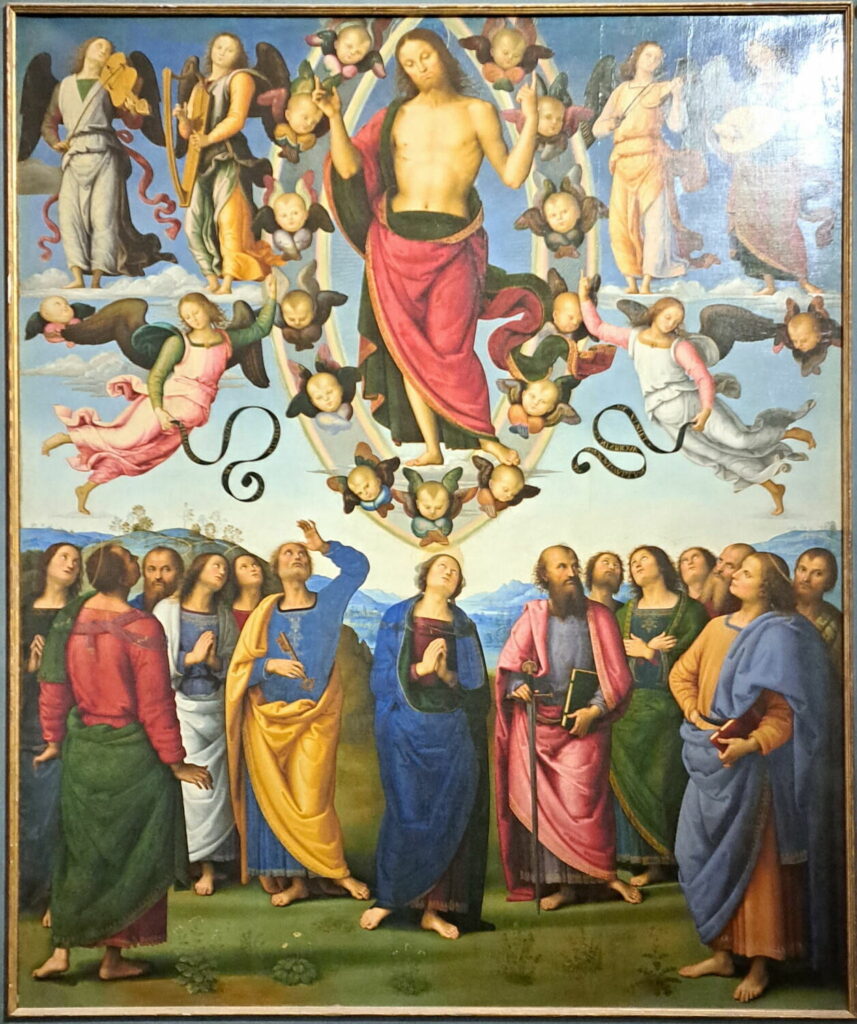Dear Brothers and Sisters, “You shall receive power when the Holy Spirit has come upon you; and you shall be my witnesses in Jerusalem and in all Judea and Samaria and to the end of the earth.” (Acts 1: 8). With these words, Jesus took his leave of the Apostles. . . .Immediately afterwards the sacred Author adds that “as they were looking on, he was lifted up, and a cloud took him out of their sight.” (Acts 1: 9) This is the mystery of the Ascension that we are celebrating today. But what do the Bible and the Liturgy wish to tell us by saying that Jesus “was lifted up”?
We cannot understand the meaning of these words from a single text or from a single book of the New Testament but rather by listening attentively to the whole of Sacred Scripture. In fact the verb “to lift up” was originally used in the Old Testament and refers to royal enthronement. Thus Christ’s Ascension means in the first place the enthronement of the Crucified and Risen Son of Man, the manifestation of God’s kingship over the world.
However, there is an even deeper meaning that is not immediately perceptible. In the passage from the Acts of the Apostles it is said first that Jesus was “lifted up” (v. 9) and then it says, “taken up” (v. 11). The event is not described as a journey to on high but rather as an action of the power of God who introduces Jesus into the space of closeness to the Divine. The presence of the cloud that “took him out of their sight” (v. 9), recalls a very ancient image of Old Testament theology and integrates the account of the Ascension into the history of God with Israel, from the cloud of Sinai and above the tent of the Covenant in the desert, to the luminous cloud on the mountain of the Transfiguration.
To present the Lord wrapped in clouds calls to mind once and for all the same mystery expressed in the symbolism of the phrase, “seated at the right hand of God.” In Christ ascended into Heaven, the human being has entered into intimacy with God in a new and unheard-of way; man henceforth finds room in God for ever. “Heaven”: this word Heaven does not indicate a place above the stars but something far more daring and sublime: it indicates Christ himself, the divine Person who welcomes humanity fully and forever, the One in whom God and man are inseparably united forever. Man’s being in God, this is Heaven.
And we draw close to Heaven, indeed, we enter Heaven to the extent that we draw close to Jesus and enter into communion with him. For this reason today’s Solemnity of the Ascension invites us to be in profound communion with the dead and Risen Jesus, invisibly present in the life of each one of us.
In this perspective we understand why the Evangelist Luke says that after the Ascension the disciples returned to Jerusalem “with great joy.” (24: 52) Their joy stems from the fact that what had happened was not really a separation, the Lord’s permanent absence: on the contrary, they were then certain that the Crucified-Risen One was alive and that in him God’s gates, the gates of eternal life, had been opened to humanity forever.

In other words, his Ascension did not imply a temporary absence from the world but rather inaugurated the new, definitive, and insuppressible form of his presence by virtue of his participation in the royal power of God. It was to be up to them, the disciples emboldened by the power of the Holy Spirit, to make his presence visible by their witness, preaching and missionary zeal.
The Solemnity of the Lord’s Ascension must also fill us with serenity and enthusiasm, just as it did the Apostles who set out again from the Mount of Olives “with great joy.” Like them, we too, accepting the invitation of the “two men in dazzling apparel,” must not stay gazing up at the sky, but, under the guidance of the Holy Spirit must go everywhere and proclaim the saving message of Christ’s death and Resurrection. His very words, with which the Gospel according to St Matthew ends, accompany and comfort us: “and lo, I am with you always, to the close of the age.” (Mt 28: 19)
Dear brothers and sisters, the historical character of the mystery of Christ’s Resurrection and Ascension helps us to recognize and understand the transcendent condition of the Church which was not born and does not live to compensate for the absence of her Lord who has “disappeared,” but on the contrary finds the reason for her existence and mission in the invisible presence of Jesus, a presence working through the power of his Spirit.
In other words, we might say that the Church does not carry out the role of preparing for the return of an “absent” Jesus, but, on the contrary, lives and works to proclaim his “glorious presence” in a historical and existential way.
Since the day of the Ascension, every Christian community has advanced on its earthly pilgrimage toward the fulfillment of the messianic promises, fed by the word of God and nourished by the Body and Blood of her Lord. This is the condition of the Church, the Second Vatican Council recalls, as she, “presses forward amid the persecutions of the world and the consolations of God, announcing the Cross and death of the Lord until he comes.” (Lumen Gentium, n. 8)
- Excerpted from a homily given at Monte Cassino on May 24, 2009.















